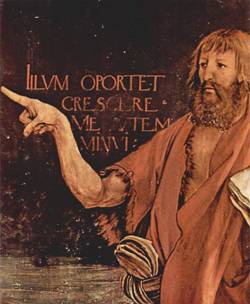
John the Baptist points to Christ, as depicted by Matthias Grünewald (1470-1528). This was a favorite image of the theologian Karl Barth.
“Advent” means “coming” or “arrival.” During the season of Advent, we celebrate Christ’s coming into the world and watch with expectant hope for his coming again. In its historical origins, the season of Advent was patterned after the season of Lent, a six-week period of penitence and preparation for Easter. Similarly, the four weeks of Advent present an opportunity for communal discernment and personal examination, as the church prepares to celebrate the Nativity of the Lord and looks with hope for Christ’s return.
Between memory and hope
An excerpt from the Companion to the Book of Common Worship (Geneva Press, 2003, 96)
In Advent we expectantly wait for the One who has already come. We anticipate the promised justice of God’s new world, yet we praise God who raised the “righteous branch” to rule with justice and righteousness. We hope for the restoration of the afflicted, the tormented, and the grieving, yet we delight that healing has come in Christ. We long for the beating of swords into plowshares, yet we rejoice that the Prince of Peace has appeared. We yearn for the barren deserts of our inner cities to flourish, yet we laud the desert Rose that has bloomed. We dream of the land where lions and lambs live in harmony, yet we acclaim the child born to lead us into the promised land.
Christ has come! Christ is risen! Christ will come again! In Advent, we are living between the first and the second coming of the Lord. The dialectical tension of maranatha [alternately translated “Come, our Lord!” or “Our Lord has come”] — placing us between memory and hope, past and future — may strengthen our Advent liturgies. Perhaps we need to cling to the ancient cry of maranatha! and its paradoxical meanings so we may freely embrace “the new thing” prophesied by Isaiah (Isaiah 43:19) that God is doing among us right now. The tension and paradox we find in Advent shapes our celebrations during the season.
Lectionary readings for Advent
Read the Revised Common Lectionary Scripture lessons for the First Sunday of Advent:
Resources for Advent
The Office of Theology and Worship has provided a collection of worship resources for Advent, including candle-lighting litanies, Eucharistic prayers, an order of worship for a service of lessons and carols, a chart with two sets of lectionary readings, and an Advent calendar starter kit.
Lighting the Advent Candles
Based on the Lectionary Passages
Scriptural calls to worship | Year B
Advent Longing for the Light of Healing Service
An advent service that starts in quiet darkness and ends after communion with “Hark the Herald Angels Sing.” Ideal for a blue Christmas service.
Prayers for Advent
These prayers might be used in a variety of settings: Opening Prayers (at the beginning of worship) or concluding collects (after the Prayers of the People); for church websites or newsletters; or in personal, small group or family devotion.
Great Thanksgiving
This is a set of brief Eucharistic prayers for the season of Advent based on the texts in the Revised Common Lectionary. The numbered sections in these documents refer to the four Sundays of Advent.
Eucharistic Prayers
for Advent Year A
Eucharistic Prayers
for Advent Year B
Eucharistic Prayers
for Advent Year C
Eucharistic Prayer for Annunciation text
(Advent 4, Year B)
This Eucharistic prayer can be used as part of a service with the Annunciation text (Luke 1:26-38) featured prominently.
Musical Settings for the Lord’s Supper
These musical settings of the responses in the Great Thanksgiving are especially appropriate for the season of Advent.
A Service of Lessons and Carols
This Service of Lessons and Carols is adapted from the Festival of Nine Lessons and Carols that has been celebrated annually at King’s College, Cambridge, for almost a century. The nine Scripture lessons are those traditionally used at the festival, while the carols provided to accompany each passage have been selected from the Presbyterian Hymnal. Pastors and church musicians are encouraged to consider other hymns or appropriate spiritual songs, taking into account the cultural context and worship style of the congregation. The multiple readings present an opportunity to involve a number of different people from the congregation in the leadership of worship. Near the conclusion of the service, a time is set aside for prayers of thanksgiving and intercessions for the church and the world.
A Service of Lessons and Carols
Alternate Lessons and Carols
Service with Communion
Contemporary Worship in Advent
Find ideas and inspiration for contemporary worship in Advent.
Daily readings for Advent
This is a chart listing daily Scripture readings for the four weeks of Advent (through Christmas Day), including two options: (1) the Revised Common Lectionary Daily Readings (coordinated with the three-year cycle Sunday readings) and (2) the Daily Lectionary readings from the Book of Common Worship (two-year cycle).
O Antiphons
Learn about the O Antiphons, an ancient prayer for Advent (and a backwards acrostic poem in Latin) and the source for the Advent hymn “O Come, O Come, Emmanuel.”
The making of Advent Wreaths
As an intergenerational event early in Advent, consider making advent wreaths for home devotional use. Here are instructions for a simple, inexpensive one.
Find resources for the Season of Advent from Biblical and Confessional Resources for Worship.
Christ the King | Nativity of the Lord